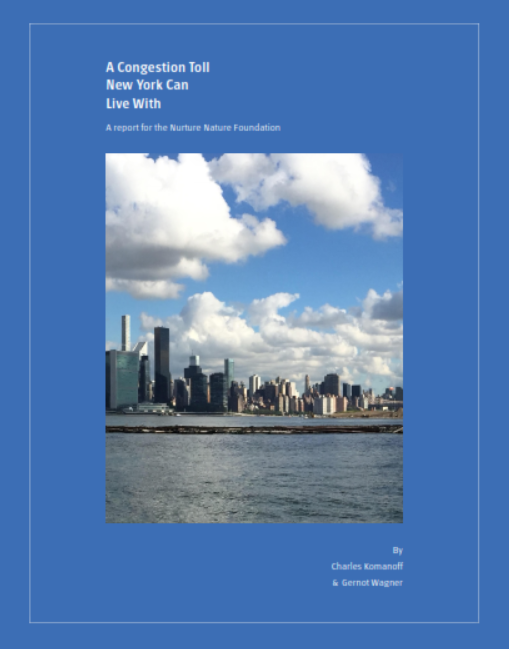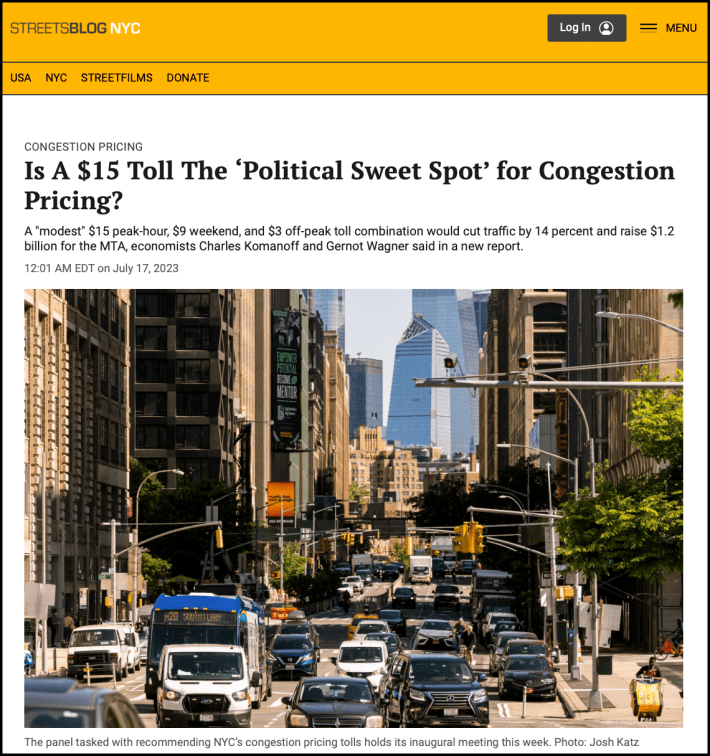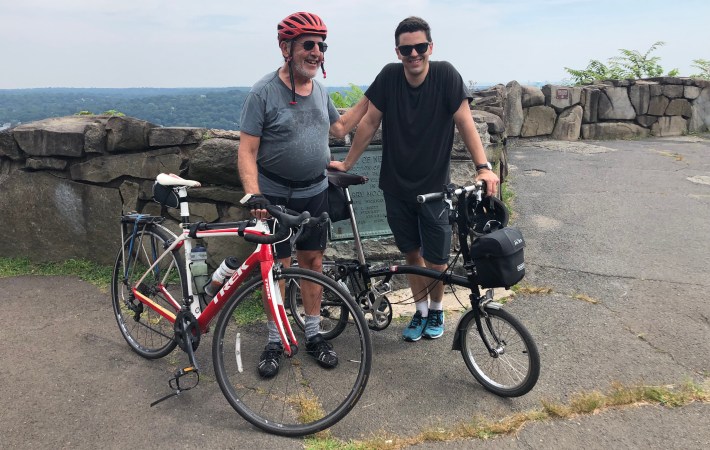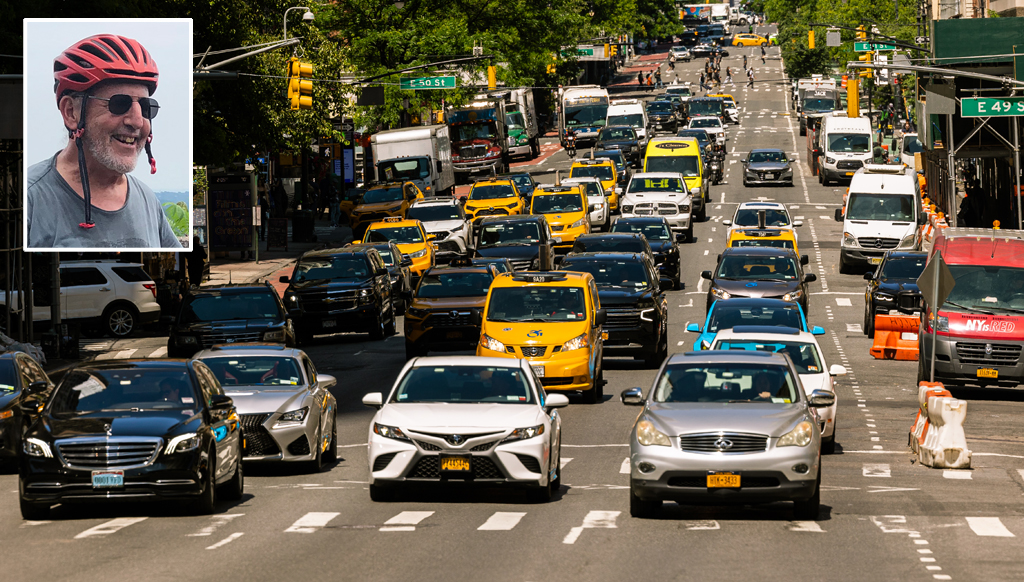This past July, Columbia Business School economist Gernot Wagner and I propounded what we thought was an ideal resolution to NY’s congestion tolling murk.

Our “15-9-3” toll plan — a $15 toll on weekdays between 6 a.m. and 8 p.m., a $9 toll on weekends from noon to 10 p.m., and a $3 levy all other times — would easily clear the annual $1 billion nut to bond the requisite $15 billion of transit improvements. Passengers in Ubers and Lyfts that touched the congestion zone would pay $2.25 on top of their ongoing $2.75 surcharge, making their congestion charge $5 per trip. Zone rides in yellows would be exempted, leaving their ongoing $2.50 charge as is.
Under this arrangement, citywide yellow trips would increase nearly 15 percent, without cutting into the ride-hails. Through a tweak of traffic chemistry worthy of Walter White, the drop in private-car use would make trips in yellows and ride-hails alike not just faster but cheaper by cutting the time component built into fares. Voilà, a gain for cab drivers and owners decimated by Uber’s trampling of their hard-won franchise. Yet Uber and its drivers would hold their own vis-a-vis the pre-congestion pricing status quo.
Despite increased Uber and Lyft trips, average car and truck speeds south of 60th Street would rise 11 percent, liberating vehicle users from 40,000 wasted hours each day, a collective time savings worth over half-a-billion dollars a year. Time savings outside the zone would be even greater, as an average 6 percent traffic speed-up percolated across many more miles driven.
This too: Built into our 15-9-3 toll structure were full congestion-toll credits for the presently tolled tunnel crossings into the zone. Inbound Lincoln and Holland Tunnel trips would enjoy minuscule congestion tolls because the Port Authority’s “incumbent” tolls ($14.75 peak, $12.75 off-peak) already exceed our congestion price ($3 to $15). Ditto for the MTA’s Queens Midtown and Brooklyn-Battery Tunnels.

Voilà again, a smackdown of NJ Gov. Phil Murphy’s and Rep. John Gottheimer’s “double toll” canard, with one exception: eastbound drivers into upper Manhattan via the George Washington Bridge would indeed pay twice, first to the Port Authority at the George, and then into the congestion kitty, assuming they in fact continued into the zone at 60th Street. Those trips’ six miles worth of congestion causation in upper Manhattan more than justified charging them the congestion zone toll on top of the bridge toll.
Our numbers were solid. We derived them using my Balanced Transportation Analyzer Excel spreadsheet that the former governor’s “Fix NYC” team used in 2017-18 to lay the groundwork for the 2019 legislation, now with updates:
- 50,000 more equations (one-half more than in 2018) to quantify new wrinkles like air emissions, traffic diversions and electric vehicles.
- Elaborate FHV tolling options to capture any contemplated Uber and taxi surcharges.
- Post-pandemic assumptions like a 10-percent drop in baseline vehicle entries, a 7-percent rise in baseline zone speeds, and lower price sensitivities from drivers even more attached to their ride.
- Reductions to baseline subway ridership, ride-hail use and, especially, yellow cab volumes.
- Dialing down from 100 percent to 50 percent the service gains assigned to the subway improvements financed by the congestion revenues.
- Doubling the percent of “non-revenue-paying” vehicles, i.e., license plate defacers, evaders and other deadbeats — authorized or not — from 2 percent to 4 percent.
These and other changes halved congestion pricing’s projected “societal net benefit” — the combined value of everyone’s time savings and greater longevity due to biking and walking more and being struck less by micron-sized particulates and multi-ton vehicles — from our prior $4 billion a year.
But even slimmed to $2 billion, our plan’s estimated annual benefits weren’t just immense, they were also robust in the sense of being nearly impossible to destroy. Overuse of motor vehicles in and en route to the city’s Manhattan core is so economically and socially destructive, and our mass transit system is so central to our metropolitan functionality, that almost any congestion pricing plan that aggressively disincentivizes the one and empowers the other can’t help but bring massive benefits.
Why, then, were Gernot and I so set on our 15-9-3 plan? And why are we gobsmacked that it has gotten so little purchase in congestion pricing discourse?
- Until it’s a done deal, congestion pricing is vulnerable. It’s a multiple transgression, contesting not just motordom, but our society’s antipathy to applying sticks — in the form of externality pricing — rather than the customary carrots of subsidies. Its magnetism for opposition transcends mere dollar and cents. The fairer we make it, the more logical and less punitive it looks, the better our chances of actually putting it in place.
- Congestion pricing in New York needs to be a forerunner of traffic pricing in other cities and metros in the United States and around the world. Losing it as time runs out, or having it lay an egg, would bottle up the ripple effect.
- New York City needs to build on congestion pricing with curb pricing, e-commerce delivery pricing, even per-mile charges on the hellspawn of unpriced, app-based, moped-borne food-delivery. Public acceptance of congestion pricing could blaze a path for all of these road-pricing follow-ons.
- Congestion pricing can also help usher in broad-based carbon pricing. Carbon taxes have lately and absurdly become anathema on the left. With vital carbon-free offshore wind megaprojects now facing financial precarity, it’s more vital than ever to create working models of externality-pricing that might help monetize clean energy’s carbon benefits.
- Good governance needs bulwarks against libertarian and right-wing scorn. Not just enacting congestion pricing but making it effective and equitable will provide powerful pushback.
Our 15-9-3 plan could have helped on all these scores. Its top toll of $15 would have provided respite from the dreaded $23. Its tunnel credits could have sacked the Jersey gang for a resounding loss. Its $2.25 add-on for Ubers without dinging the yellows would have won fans among the 99 percent. Its simplicity could have shown that wonky policy need not be esoteric.
And I’ll say it: the fact that it grew out of a homemade Excel file and a pair of dyed-in-the-wool city cyclists would have been sweet icing on the congestion pricing cake.

I’ve written in subjunctive voice because neither 15-9-3 nor the BTA is in the picture — not since we published our toll paper in July, and certainly not now, with the Traffic Mobility Review Board apparently ready to drop its toll recommendations in a few weeks. One panel member reportedly said that every time s/he raised Gernot’s and my tolling ideas with the MTA, “they have a heart attack.”
So Rest in Peace, 15-9-3. Let’s hope whatever toll rabbit the panel pulls out of the hat this month breeds contentment, not contempt.






